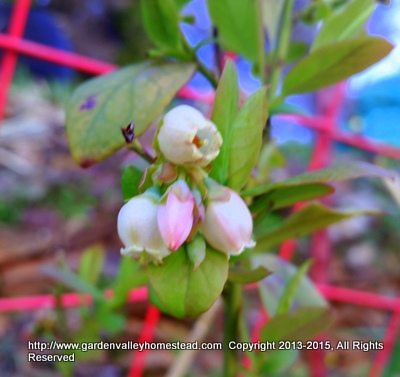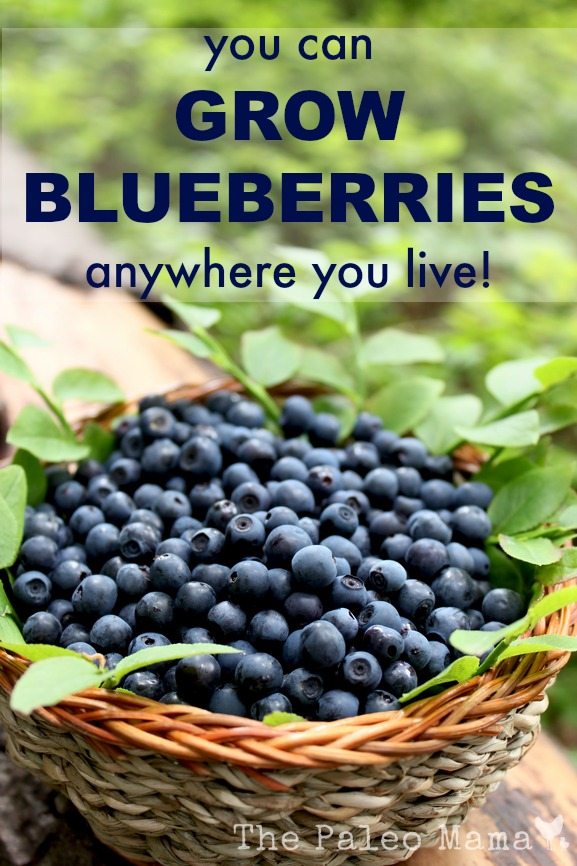

Today I’m welcoming Sally from Garden Valley Homestead as she shares her knowledge on how to grow blueberries ANYWHERE!
Ever have one of those moments when you think, “I wish I knew that sooner!”. That’s what I thought when I learned you can grow blueberries just about anywhere in the United States. I was under the impression that blueberries only grow in cold climates of the northeastern United States.
Not so!
Know Your Chill Hours
Well, yes, it’s true they grow well—very well, in the northeastern United States. But, guess what? They grow very well in a lot of other states, too! You simply need to know your average number of chill hours for your area and choose a blueberry bush accordingly.
What’s A Chill Hour and Where Can I Find One?
A “chill hour” is any hour where the temperature is under 45 degrees Fahrenheit. (If you’re growing any kind of fruit tree, it’s good to know your chill hours.)
If you’re a weather geek and own a fancy weather station, you can track it yourself. (I mean that in a nice way. Gardeners are usually interested in the weather. We kinda have to be….) Or, do what I do: contact your local agriculture extension department. They keep track of that sort of information for you.
Chill Hour Cheat Sheet
- If you live in Zones 5-9, your average number of chill hours is 500
- If you live in Zones 4-7, your average number of chill hours is 1000+
Why is this important? Blueberries need a specific number of cold hours each winter to regulate their growth. If a blueberry bush doesn’t experience enough cold in the winter, the flower buds might not open at all in spring, or they might open unevenly.
Your best bet to ensure your successful blueberry growing experience is to call your local agriculture extension office or Master Gardener’s program to ask for the average number of chill hours. They might publish the information on their web site. Look and see.
Match Your Blueberry Plant to Your Chill Hours
Now that you have a firm grip on the chill hours for your area, choose blueberry plants that thrives in that environment. Most likely, you’ll choose a Northern Highbush or a Southern Highbush. I recommend buying bare root plants from a reliable grower. I order bare root plants and trees from Peaceful Valley Nursery
- If your chill hours average 800-1,000, choose a Northern Highbush.
- If you chill hours average 150-700, choose a Southern Highbush.
Rabbiteye variety is native to the southern United States. Chill hours needed for this type of blueberry bush are 350-700.
However, Northern Highbush and Southern Highbush are the two most common varieties. Blueberries from these plants varieties are those you most often find in stores.
Pick Two or Three Varieties for Cross-Pollination
Blueberry plants need to be cross-pollinated with other blueberry plants of a different variety. So when you’re choosing your Northern or Southern Highbush plants, pick two or three different kinds to ensure they will bear fruit. Also, study the plants to learn whether they are early-, mid-, or late-bearing plants. Pick a variety to extend your growing and harvesting season.
Now you know how many chill hours you have in your garden and which plants thrive in your environment. Next, you need to prepare your soil.
Blueberry Bushes Like Acidic Soil
Blueberry bushes of all kinds are acid-loving plants. They like a pH level of 4.0-5.0. If you don’t live in the arid West, your soil pH is probably near the 4.0-5.0 range already. But, if you live in the West, your soil is probably alkaline and you need to amend it to bring down the pH level.
Use a simple soil testing kit like this one to discover the pH level of your soil. You should be able find soil testing kits at your local garden center.
Growing blueberries in containers makes it easy to maintain soil pH. Bonus: You don’t have to dig a hole! I grow just about everything in SmartPots.
Blueberry bushes like this soil recipe:
- 1 part organic potting soil for nutrients
- 1 part peat moss or coco peat for moisture
- ½ lb. Acidic mix per cubic foot of soil.
Plant Your Bare Root Plant in Containers or Directly Into The Ground
- If you’re using a container, choose one the allows for 20 inches of root depth. I plant blueberries in 30 gallon SmartPots.
- Fill your pot with soil and amendments. Use the recipe above, if you like.
- Plant your blueberry bush to the same depth it was planted when you received it.
- Mulch well (3 inches deep) with straw, shredded leaves, pine needles, wood chips or well-aged sawdust from wood NOT treated with a preservative.
- Water well. Blueberries need one-to-two inches of water each week.
If you’re planting straight into the ground:
- Work up a planting area approximately 2-1/2 feet in diameter and one foot deep.
- Remove 1/3 to 1/2 of the soil. Add the soil recipe above.
- Plant your blueberry bush to the same depth it was previously planted.
- Water and mulch.
- Don’t fertilize until spring.
Caring for Your Blueberry Bushes’ During It’s First Year in Your Garden
Blueberry bushes are moisture sensitive. They like their soil to stay moist, but not soaking wet. Your plant’s leave will tell you if the water content is too much of too little.
Things To Do:
- When your plant’s flowers begin to bud in the late winter or early spring, pinch off the flowers to encourage a strong root system. Sorry. You have to wait for the second or third season to begin harvesting your beautifully nutritious berries.

- Prune away any damaged, blotchy and dead branches, twigs, or side shoots.
- Fertilize your plant(s) in the early and late spring with an acid fertilizer like this one, and again in the fall. But, use half as much fertilizer in the fall.
- Freshen up the mulch.
- When the berries start to “show color”, protect them from birds with netting. I like to create PVC arches over the plants and secure them so the nets don’t blow away and birds can’t sneak inside the nets. Pinwheels stuck inside the beds next to the bushes seem to work to scare birds away. You can buy pinwheels from the Dollar Store then “plant” them with blueberries.
- If deer cross through your property, you already know to keep your blueberry bushes behind deer fencing.
If you follow these steps, you should enjoy a delicious harvest of berries to eat fresh or preserve any number of ways. Hint: Flash freezing washed berries on trays is EASY and maintains the most nutritional value. Plus, you’ll have a stash of fresh berries available well beyond the growing season.
ABOUT THE AUTHOR:
 Sally Olson is a homesteader, writer, wife, homeschool mom, and an idealist. She blogs to encourage others to pursue their homestead-DIY-healthy living dreams. All her posts are gluten-free at Garden Valley Homestead. Sally, her husband of 25 years, two sons, horses, Labradors, and hens are blessed to call the Sierra-Nevada Foothills home. You can find her on Facebook, Pinterest, and Twitter!
Sally Olson is a homesteader, writer, wife, homeschool mom, and an idealist. She blogs to encourage others to pursue their homestead-DIY-healthy living dreams. All her posts are gluten-free at Garden Valley Homestead. Sally, her husband of 25 years, two sons, horses, Labradors, and hens are blessed to call the Sierra-Nevada Foothills home. You can find her on Facebook, Pinterest, and Twitter!

If you plant the blueberries in a pot what do you do with them in the winter?
hi,I live in central Ky.and wanting to grow blueberries,can I plant them in seasoned mulch ?
I would suggest you do a soil test to be sure before you try to plant in seasoned mulch.
“No matter where you live”… unless you don’t live in the States…
Hello Do you have a picture of how you set up the netting?
hi
i live in iran and i study horticulture. i like to grow blueberry here but we have alkaline soil and warm clima. how can i do this . how can i release ph?
thanks
CAN YOU PLEASE SING ME UP FOR YOUR EMAIL NEWSLETTER.
Hey Sally,
Thank you so much for the information on blueberries- we’re looking to plant some in pots this year, since our in-ground plants failed. We probably could have nursed them along with all of the clear information in your post, and now I can’t wait to make another try at it.
I live in an apartment and my sun exposure is North-Northeast. Is that enough sunlight for Blueberries?
I contacted my Agricultural Extension Service and they said that with Alkaline soil, you can not grow blueberries, even if you add acidic supplements to the soil, because not only is the soil alkaline, but also the rain is alkaline… I have, yet, to find a blueberry bush that has lived longer than 2 years. They shrivel up and die in our highly alkaline soil and rain….